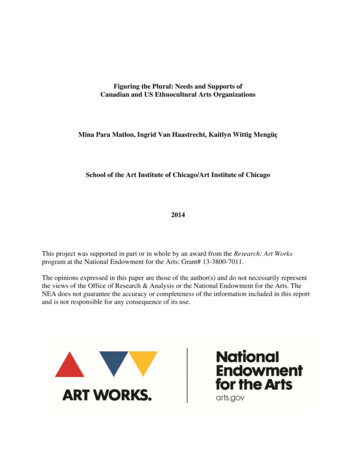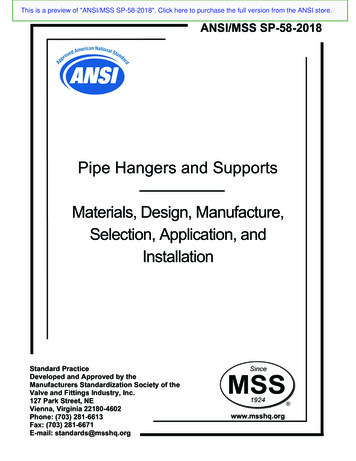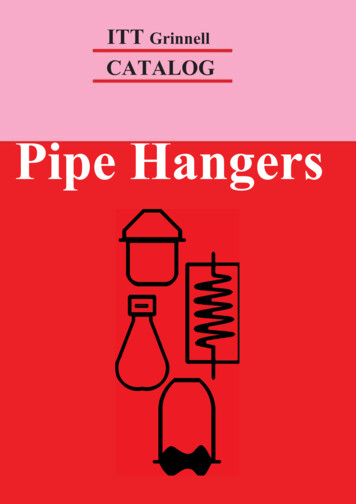
Transcription
Learning Strategies, Supports, and Interventions4. LEARNING STRATEGIES, SUPPORTS, ANDINTERVENTIONSThis section will review strategies for meeting student learning needs —differentiated instruction, adaptations, supports, modifications, andindividualization discuss communication issues as they relate to the child who isalcohol-affectedAddressing Student Diversity in Manitoba SchoolsToday’s classroom reflects the diversity of our communities and includes a mixof student interests, needs, learning styles, and cultural backgrounds. ManitobaEducation, Training and Youth has described instructional supports that addressthis diversity. They can be visualized as a nested continuum that is consistentwith the concepts of inclusion, effective professional practice, and collegialsupport.Continuum ofInstructionalSupports forAddressing StudentDiversityProvincial Curriculum(including DifferentiatedInstruction)AdaptationsSupport PersonnelProfessionalPracticeRedesignedCourse ingInclusion4.1
Towards Inclusion: Tapping Hidden StrengthsTeacher Planning in the ClassroomAt the beginning of the school year, the teacher should clearly establish theneeds of the students in the classroom. In almost every classroom there will bestudents who require special consideration. Remember, the teacher is notexpected to provide totally different programs to students; rather, the differencescan be managed using a variety of approaches.The teacher should determine the best methods to address students’ needs. In atypical classroom, there may be several students who require differentiated instruction (Note that all studentsbenefit from differentiated instruction, but for some students it is essential.) some students who require adaptations to instruction and assessment some students who require additional supports a few students who require modifications outlined in their IndividualEducation Plan occasionally students who require individualized programming outlined intheir Individual Education PlanThe teacher should examine ways to meet the learning needs within the unit orlesson being taught. A teacher who examines the needs of a classroom in thisway is able to see commonalties as well as differences in students. A classroomthat includes students who are alcohol-affected might also have other studentswhose learning needs can be met in the same way. The Unit Planning form is anexcellent way of planning for a variety of needs.**4.2
Learning Strategies, Supports, and InterventionsThe following is an example of how a geography unit could be developed tomeet the needs of all students in a classroom.Senior 2 Geography: Unit 1 - Overview of North AmericaLearning Outcomes: Where is North America located? Which countries are included in North America? Which national boundaries will be significant? Why?Class instruction:Complete the map of North America by writing the provinces/states, capital cities, and majorrivers/bodies of water. Include a legend that indicates the general topography and the majorindustry associated with each province.Differentiated instruction for all students: Use overheads and videos Enable students to conduct research using computers, CD-ROMs, and the Internet Make a class project of building three-dimensional map, and provide separate areas wherestudents can work at various times Provide a variety of materials to students (e.g., modeling clay, small objects)Differentiated evaluation/assessment: Develop a rubric to weight various types of finished products (e.g. written format, picture format,oral presentation). Assess student knowledge of specific content and various levels of expectedperformance.Possible adaptations: Provide a word bank of provinces, rivers/waterways Provide pictures of major industries and topography for students to place on maps. Put thepictures of trees, prairies, and mountains on the map. From the list of jobs (fishing, farming,mining, etc.) select one or two that are found in each province and write the job(s) on the map. Enlarge maps for easier labelingPossible supports: Librarian Resource ParaprofessionalPossible modifications: (the extent of the modification will be dependent on the studentsfunctioning level. Modify only to the extent that is necessary.) Provide a map of the provinces and instruct students to colour each province a different colour(e.g., British Columbia - blue; Manitoba - pink) Provide a labeled map and ask students to locate specific places on the map (e.g., underline theRed River; find Hudson Bay and colour it blue) Use pictures (e.g., of fish, tractors) to represent major industries in a province, and ask studentsto match the pictures with the appropriate province(s) Provide a map of Manitoba only. Ask students to locate Winnipeg and two major rivers. (This isappropriate for small group work - one student could work on the Manitoba map while the otherswork on a map of the country. The Manitoba map could then be included on the final, larger mapof the group.)Possible activities for students on an individualized program: Provide students with maps of the school, classroom, or community to help them learn functionalmapping skills as they relate to their environment. Working on bus schedules is an example of afunctional mapping skill.In the sections below, additional information, strategies, and suggestions areprovided regarding differentiated instruction adaptations adding support team members designating courses as “modified” individualized programming4.3
Towards Inclusion: Tapping Hidden StrengthsProvincial Curriculum with DifferentiationThere are four programs in Manitoba: English, French Immersion, Français, andTechnology Education. The first three are available from Kindergarten toSenior 4, while Technology Education is only available at the Senior Years.Each program is organized in domains (subject areas) which, in turn, haveprovincial curricula that are organized around learning outcomes and describecontent and methods for instruction.Differentiated instruction refers to a wide range of instructional and classroomstrategies that teachers can use to help each student achieve the prescribedlearning outcomes. It is the component of classroom instruction that specificallyacknowledges and responds to learner diversity. Using differentiated instructionestablishes a supportive learning environment for all students.Differentiated instruction helps teachersprovide provincial curricula byaccommodating students with a widerange of abilities, interests, and learningstyles. Teachers can differentiatecurriculum in three broad areas: content,process, and product.For a full description ofdifferentiatedinstruction, see Successfor All Learners: A Handbook onDifferentiating Instruction(Manitoba Education andTraining, 1996).Differentiated instruction helps studentsmeet provincial curricular outcomes because varied instructional approaches areused, thus matching their varied learning styles.There are many differentiated instruction techniques that have been found towork effectively with students who are alcohol-affected. Because these studentsmay experience difficulty with receptive and expressive language, withremembering, and with understanding abstract ideas, techniques need to bechosen with care.Students who are alcohol-affected prefer activities that involve concrete learning visual/tactile/kinesthetic learning stylesThe strategies below can help students who are alcohol-affected (and may alsobe effective with many students who are not). In using these strategies, teachersneed to remember that strategies may need to be explained to students severaltimes. There are six examples of differentiated instruction approaches providedon the following pages.4.4
Learning Strategies, Supports, and InterventionsLearning StrategiesExamples ofDifferentiatedInstructionLearning strategies are instructional strategies that have been developed to assiststudents with learning difficulties. Learning strategies include: teaching studyskills, editing assignments, reading strategies, and thinking strategies. Twoexamples of learning strategies that can be used with students who are alcoholaffected are the COPS strategy and the JETS strategy. LearningstrategiesCOPS is an editing strategy that helps students edit their work by focusing onfour key elements of the editing process: GraphicorganizersC Capitalization Lesson framesP Punctuation OrganizationalstrategiesO Overall Editing and AppearanceS SpellingAdditional informationon learning strategiesis available from theUniversity of KansasInstitute for Research inLearning Disabilities. Note-takingJETS is a strategy for taskcompletion or assistance in preparingto do an assignment. ScaffoldingJ Job: What is it I have been asked to do?E Equipment: What will I need to do the job?T Time: How much time do I have to complete the job?S Satisfactory product: What do I have to do to complete my job in asatisfactory manner?Graphic OrganizersFor a detailed*Graphic organizersexplanation of graphic(also known as mindorganizers see Successmaps, webs, clusters, for All Learners: A Handbook onthink sheets, andDifferentiating Instruction(Manitoba Education andforms) are visualTraining, 1996).diagrams that helpstudents understandand think by representing abstract ideas and concepts in a concreteform (see the following examples).4.5
Towards Inclusion: Tapping Hidden StrengthsLesson FramesLesson frames are used to present an overview of a lesson or concept. They arepresented in writing but may also include pictures or graphics, and are usuallyplaced on overheads, photocopies, chalkboards, or posters. They typicallyindicate the course, topic, date, lesson outline, lesson outcomes, assignment, andnotes. Lesson frames help students to organize their thoughts around a lesson.'1994 Deneba Systems,The use of visuals (pictures or graphics) in lesson frames can helpstudents learn important routines or strategies. Visuals can be made usingcomputer programs, magazine cutouts, or photographs, and placed instudent binders for easy access. The student’s schedule may berepresented by picture activities scheduled for the day. Visuals may alsobe used during class presentations to reinforce verbal and writteninformation.Organizational StrategiesOrganizational strategies are techniques that can be used to helpstudents organize books, materials, and activities. Some techniquesthat have been found to work with students who are alcohol-affectedinclude colour-coding the student’s notebooks, texts, and file folders bysubject or assignment (e.g., red for mathematics) using an agenda book to keep track of homework, school events, tests, andassignments that travel between home and school labeling items that should be kept in the student’s locker using small containers to store school supplies providing additional shelving in lockers, especially for Middle Years andSenior Years students4.6
Learning Strategies, Supports, and InterventionsNote-TakingStudents who are alcohol-affected may experience difficulty while note-taking.This problem can be resolved by providing the student with a photocopy of apeer’s notes, the teacher’s notes, or the class overheads. Some teachers removekey words from overhead notes so that the student will be required to payattention to the presentation in order to fill in the missing words.ScaffoldingStudents who are alcohol-affected may becomefrustrated when presented with a largeassignment or research project. It is possible toavoid this frustration by using scaffolding – astrategy of providing clear structure andprecisely stated expectations, and breakingdown tasks into manageable pieces.For additionalinformation onscaffolding, andexamples of projectsthat have been designedusing scaffolding and technology,visit www.fno.org/dec99/scaffold.html (From Now On: TheEducation Technology Journal)and http://edweb.sdsu.edu/webquest/webquest.html (TheWebquest Page).Scaffolding Benefits provides clear directions clarifies purpose keeps students on task points students to worthysources reduces uncertainty,surprise, and disappointment helps students to organize breaks the work down intomanageable pieces provides a structure forcompleting the project4.7
Towards Inclusion: Tapping Hidden StrengthsAdaptationsAdaptations are planned, personalized alterations in the way teachers provideinstruction, in the way a student demonstrates learning, and in the assessment ofprogress. Adaptations help students to achieve and to demonstrate theachievement of the expected learning outcomes of the curriculum. Adaptationsare developed for individual students through planning by the teacher, student,parents and possibly other support personnel. Students are assessed according tothe learning outcomes of the provincial curriculum.There are a variety of ways that educators can provide adaptations for anindividual student. These include adaptations to the physical and/or social environment materials and resources, including the introduction of supportive equipment presentations testing and assessment procedures (prior permission is required forprovincial standards tests) assignments and projects organizational supports the time required to achieve curriculum outcomes4.8
Learning Strategies, Supports, and InterventionsPossibleAdaptations for theChild Who isAlcohol-Affected*Presentation FormatResponse FormatEnvironment/Setting Break tasks down into smallsteps Scribe Alternate space in room Word processor/typewriter Alternate setting Books on tape Oral reporting/testing Carrels Large print Underline key concepts Picture, diagrams, drawing,poetry, etc. Reduce stimuli insurrounding area Video/movie of the novel Dictaphones Move and sit cushions Advanced organizers Adapted desks or seating Manipulatives Acoustical treatments(carpet)Time Reducing number ofquestions or extendinglength of time to co
Response Format Scribe Word processor/typewriter Oral reporting/testing Picture, diagrams, drawing, poetry, etc. Dictaphones Environment/Setting Alternate space in room Alternate setting Carrels Reduce stimuli in surrounding area Move and sit cushions Adapted desks or seating Acoustical treatments (carpet) Time Reducing number of questions or .











